St. Malachy's Prophecy of Popes and Antipopes
Bro. Michael Dimond ( www.vaticancatholic.com )
________________________________________________"One of the most well known predictions in Catholic history is the prophecy of the Popes and Antipopes that is attributed to St. Malachy.
St. Malachy was a Catholic Bishop born in 1094 in Ireland. He died in the presence of his good friend, St. Bernard in 1148. St. Bernard said that St. Malachy foretold the day and hour of his own death. St. Malachy was canonized in 1190.
In a reading for his feast day
mentions that he was blessed with the gift of prophecy.
 |
| St. Malachy |
 |
| St. Bernard and St. Malachy |
De Wyon was assisted in his translation of the document by Alfonso Chaconne, a well known scholar of medieval manuscripts. Chaconne was given the job of authenticating the document and making sure it wasn't a forgery. After examining the document, Chaconne verified it as authentic.
 |
| 1913 Catholic Encyclopedia |
St. Malachy was simply shown the men, who until the end of human history, would present themselves to the world as the leaders of the Catholic Church. Furthermore, as humanity moved closer and closer to the end of the world, God wanted people in the last days to have some idea how close they were to the Second Coming of Christ.
 |
| The Vatican - the Papacy |
St. Malachy also described major figures or events that would overshadow the reigns of some of the claimants to the Papacy.
As mentioned earlier, the prophecies of St. Malachy were published for the first time in 1595.
 |
| St. Malachy's list of Popes before 1595 |
However, a good response to that objection can be found by considering a very important Biblical manuscript called "Codex Vaticanus." Codex Vaticanus is considered to be the oldest surviving copy of an almost complete Bible,
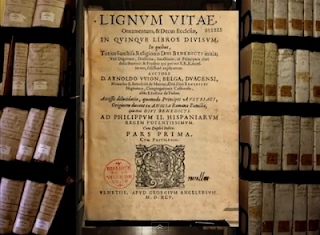 |
| St. Malachy's prophecies first published in Lignum Vitae in 1595 |
It was originally produced in the late 4th century, but its whereabouts were uncertain for more than one thousand years until it was identified in the Vatican Library in the 15th century.
So, Codex Vaticanus, like St. Malachy's document was discovered at the Vatican after being lost for an extremely long period of time, yet Biblical scholars generally accept Codex Vaticanus as authentic, despite its uncertain whereabouts for more than 1000 years after its original production, a far longer period of time than St. Malachy's document was lost.
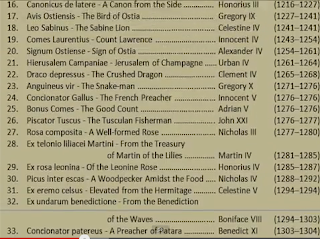 |
| St. Malachy's List of Popes before 1595 |
Nevertheless, since there is controversy over the St. Malachy prophecy before 1595, we will not consider any examples of his predictions that concern Papal claimants before 1595, but only those after 1595.
St. Malachy describes Pope Innocent X as "Joyfulness of the Cross."
 |
| Pope Innocent X - [1644 - 1655] |
It is very interesting that Innocent X was finally elected Pope on the feast day of the Exultation of the Cross, after a long and difficult conclave.
St. Malachy describes Pope Pius VI as "Apostolic Wanderer."
 |
| Pope Pius VI - [1775 - 1799] |
During Pius VI's reign, he travelled to Germany to confer with Emperor Joseph II. In the last two years of his reign, he was forced by revolutionaries to flee Rome. After a very difficult journey over the Alps, he died in France. He was definitely a "Wanderer."
St. Malachy describes Pope Pius VII as "Greedy Eagle."
 |
| Pope Pius VII - [1800 - 1823] |
After Pius VII excommunicated Napoleon, he was kidnapped and imprisoned by Napoleon's officers. Eventually Napoleon formed an agreement with Pius VII that weighed heavily in his own favour.
 |
| Pope Pius IX - [1846 - 1878] |
St. Malachy describes Pope Pius IX as "Cross from the Cross."
Pius IX was the last Pope to govern the Papal States. He ended up a prisoner in the Vatican after the House of Savoy, whose coat of arms is a White Cross, reunited Italy and removed Pius IX from his control of the Papal States.
 |
| Pope Leo XIII - [1878 - 1903] |
Pope Leo XIII's coat of arms features a comet in the sky. Bishops of the Catholic Church create a coat of arms. Pope Leo XIII was made a bishop on February 19, 1843. That means that Leo XIII created his coat of arms which featured a comet in the sky, 35 years before he became Pope in 1878. He was thus identified with a light in the sky long before he became Pope, or knew that he would become Pope.
 |
| Coat of arms of Pope Leo XIII |
St. Malachy describes Pope Pius X as "Fire Burning."
 |
| Pope Pius X - [1903 - 1914] |
St. Malachy describes Benedict XV as "Religion Laid Waste."
 |
| Pope Benedict XV - [1914 - 1922] |
St. Malachy describes Antipope John XXIII as "Pastor and Sailor."
 |
| Antipope John XXIII - [1958 - 1963] |
During his reign, John XXIII would frequently wear clothing featuring a large sailboat.
St. Malachy describes Antipope Paul VI as "Flower of Flowers."
 |
| Antipope Paul VI - [1963 - 1978] |
St. Malachy describes Antipope John Paul I as "From the Half
Moon."
John Paul I began his reign on August 26, 1978 when the moon appeared exactly half full.
 |
| Antipope John Paul I - [1978 - 1978] |
So he literally began his reign from the half moon. John Paul I also comes from the diocese of Belluno, which means "Beautiful Moon."
St. Malachy describes Antipope John Paul II as "Of the Solar Eclipse."
John Paul II was born on May 18, 1920, the day of a solar eclipse. On the day of John Paul II's funeral, April 8, 2005, there was also an eclipse of the sun. This is a striking fulfilment of St. Malachy's prophecy. In the apparitions of Our Lady of La Salette, France, September 19, 1846, the Blessed Virgin Mary appeared to two little children and said, "Rome will lose the faith and become the seat of the Antichrist. The Church will be in eclipse."
 |
| Antipope John Paul II - [1978 - 2005] |
Our Lady predicted that outside a remnant of Catholics who will preserve the true faith, most people will not see or find real Catholicism because for one reason, the Church will seem to be dominated, blocked out or eclipsed by something.
That something was John Paul II. He was the eclipse of the Catholic Church.
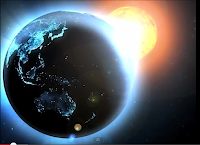 |
| Eclipse of the Sun |
According to St. Malachy, the final claimant to the Papacy in the history of mankind is described as "Petrus Romanus" - Peter the Roman
 |
| Peter the Roman |
If St. Malachy's prophecy is correct, Antipope Francis will be the last person in history who will claim to be the Bishop of Rome.
 |
| Malachy's prophecy about to be fulfilled |
Keep in mind that St. Malachy predicted both Popes and Antipopes, whoever would claim to be the Bishop of Rome.
 |
| Destruction of Rome commences |
Non-Catholics who believe in St. Malachy's prophecies, yet reject the Roman Catholic Church, should deeply consider what St. Malachy says here. He refers to the Roman Church which everyone admits is the Roman Catholic Church, and he calls it "Holy."
 |
| Malachy's prophecy |
If the Roman Catholic Church were a false Church, there would be no way that St. Malachy would describe it as "Holy," and only God could have given St. Malachy the ability to make such incredible accurate predictions about the future.
God would not have given such incredible insights about future events to a believer and leader of a false religion.
What is also extremely interesting is that St. Malachy describes Rome being destroyed by fire at the end of Francis' reign.
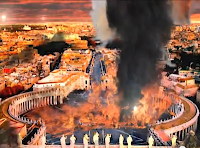 |
| Destruction by fire |
If correct, this fits perfectly with the prophecies in the Apocalypse about how Babylon/Rome is destroyed at the end of the world.
These issues are covered in much more detail in our video, "Is theWorld about to End?" This video contains stunning information about how the final claimants to the papacy fit into Biblical End Times Prophecy.
 |
| Rome is destroyed |
Therefore, if St. Malachy's predictions are correct, Antipope Francis will be the last claimant to the papacy in history; so if 1000 years from now, we were to look back at the complete list of Popes and Antipopes in history, Francis would be described as the one at the end of the world.
 |
| Destroyed by fire |
Perhaps, in a way of unknowingly fulfilling prophecy, Francis made the following striking statement in his opening words to the people, after his "election" as Antipope, that is, during his very first address to the world from the balcony of St. Peters.
 |
| End of the world claimant to the Papacy |
Francis said, " The other 'Cardinals' went all the way to the end of the world to find him," and then added, "Here we are."
Translator of Francis' address: " You know that the duty of the conclave was to give a bishop to Rome. My fellow 'Cardinals' went and found one, all the way at the end of the world, but, here we are."
 |
| "But here we are." - The End. |

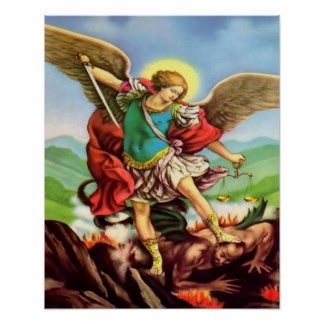


No comments:
Post a Comment